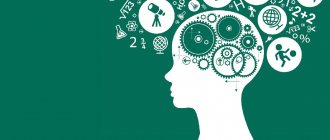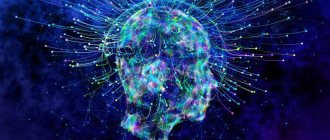The concept of mental phenomena
In order for us to talk to you about mental processes, we will need to recall the materials from previous lectures.
We talked about the fact that any science (including psychology) has its own object and subject of research. Object
of any science is what the research as a whole is aimed at, and
the subject
is that part of the object that is studied using the categories, principles and methods of a particular science.
| Science object – an area of reality, a set of real phenomena and processes, the study and justification of which this branch of scientific knowledge is aimed at. The object of science is the area of reality around us that is at the center of research. The object of science usually represents a fairly broad sphere of reality, which, due to its complexity and multidimensionality, allows and even requires “participation” in its justification of a variety of sciences. | |
| Science subject – a side of an object, a certain aspect of it, studied in a particular case; that side of the object to which specific research in a given field of scientific knowledge is aimed | |
At the first lecture, we found out that the object of study of psychology is a person. But every humanistic science (from the Latin humanitas –
human nature) has its own interest in man: for example, anatomy studies the structure of man, physiology
-
the functioning of his organs, sociology
-
his interaction in society, in the conditions of social communities and groups, anthropology
-
the origin and evolution of the physical organization of man, etc.
Although psychology uses the results of research from all these sciences, it still has its own subject of research. And we found out that the main subject of scientific research in psychology is the human psyche.
What is the psyche? We cannot directly see or touch it. The human psyche appears to us in the form of emotions, features of thinking, reactions to various external stimuli, that is, in the form of various kinds of features of our behavior and mental life that are available to us for direct observation.
These mental characteristics of a person that we observe are called phenomena in psychology. This term came to psychology from philosophy, where it 2
usually denote everything that can be known sensually (through sensations).
For example, lightning or smoke. These are phenomena because we can directly observe them, but we cannot observe the chemical and physical processes behind these phenomena (which caused these phenomena); they can only be recognized through the prism of the analytical apparatus. Therefore, these chemical and physical processes are not phenomena.
It's the same in psychology. What can be recognized by any untrained observer, such as memory or character, are classified as mental phenomena. The rest, hidden, is considered psychic mechanisms.
For example, this may be features of memory or psychological defense mechanisms. Of course, the line between phenomena and mechanisms is quite fluid. However, the term “mental phenomena” is necessary to designate the range of primary information that we receive about behavior and mental life.
| Psychic phenomena – this is a general psychological category that includes various manifestations of the psyche that are closely interconnected and interdependent; elements of the subject's internal experience; manifestations of human mental activity, which are used by psychology to study the psyche - its properties, functions, patterns. | |
1.1. Objective and subjective mental phenomena
Mental phenomena are very diverse, so their classification can be made on a number of grounds. Mental phenomena can be divided into objective and subjective (Fig. 1).
Objective phenomena
accessible to an external observer.
Objectivity
– independent of the will and consciousness of people, cleared of emotions, an impassive look from the third position of perception, from the position of an outside observer; an attitude towards something based on the properties and characteristics of this something; one’s own feelings (attachment, sympathy, antipathy) are not taken into account.
Signs of the objective: physical, obvious or real to all who perceive it, accessible to public verification and reliable, fixed as independent of the subject, external to the body or consciousness, free from mental or subjective experience. One can add to the characteristics of the objective: reproducible with virtually no changes noticeable to the observer when repeating the same conditions of perception, predictable, obeying known physical laws.
Subjective phenomena
accessible only to the internal observer (then
eat to their owner). 3
Subjectivity
- is an expression of a person's ideas
(the thinking subject) about the world around him, his points of view, feelings, beliefs and desires; “personal opinion”, judgment based on emotions, characteristics of a person’s inner world. In philosophy, the term is usually contrasted with objectivity.
Main signs of subjective:
internal, personal, inaccessible to public consideration, felt or mental, not directly confirmed by others, determined by personal, emotional assessments, unreliable, biased.
Of course, there are phenomena that can be classified as both subjective and objective. For example, these are emotions. On the one hand, emotions are perfectly “read” by outside observers, on the other hand, only the owner of the emotion can feel it to the end, and despite external similarity, emotions can differ greatly.
Facts of internal
subjective human experience
| Objective | Subjective |
| Available to external observer | Not accessible to outside observers |
Rice. 1. Classification of mental phenomena depending on their perception by the subject
Manifestation of consciousness in behavior, mental processes, properties and states of a person.
Manifestation of consciousness in behavior, mental processes, properties and states of a person.
Consciousness is the highest form of mental development, inherent only to humans, manifested in complex forms of reflection of the world, mediated by the socio-historical activities of people.
The main characteristics of consciousness are:
- reflection of the surrounding world using cognitive processes (sensation, perception, memory, thinking, imagination). Violation of any of the cognitive processes leads to a disorder of consciousness;
- the distinction between subject and object, which occurs in the process of forming a person’s self-awareness. Man is the only living being capable of self-knowledge;
- self-assessment of one’s actions and oneself in general;
- ensuring purposeful human activity;
- the presence of emotional and evaluative relationships to everything that happens around, to other people and to oneself. This characteristic of consciousness manifests itself most clearly in such moral feelings as a sense of duty, patriotism, internationalism, etc.
Through consciousness, a person is able to cognize the essence of the surrounding world, understand it and at the same time know about what she knows or does not know
Basic manifestations of consciousness include:
- a person’s general sensitivity to socially significant manifestations of other people, or what is commonly called sensitivity in the general meaning of the word;
— human activity in the sphere of social relations, which is called initiative;
— a person’s reactivity to social influences on him, or his responsiveness;
- the ratio of initiative and responsiveness as a general manifestation of socialization, or a person’s subjective involvement in public life.
The secondary vital manifestations of consciousness include:
- personal tempo, or social time of human life in the conditions of society;
- social plasticity and/or rigidity, which in practice is consistently designated as a person’s education in the form of his awareness, skill, and upbringing in current relationships. In cases of perfect education, the reflexivity of all this is also assumed. However, reflexivity is not a universal mental formation at the level of consciousness;
— social extra-/introversion of a person is well known to all students and even schoolchildren. This is the sociability and/or isolation (in the form of self-sufficiency) of a person in interpersonal relationships at the everyday level;
- and, finally, social excitability, or what is usually called a person’s justice and/or his indifference in interpersonal relations.
Manifestation of the unconscious in behavior, mental processes, properties and states of a person.
Unconscious —
those mental phenomena and processes that are not realized by a person or are not controlled by him.
Any manifestation of the unconscious is a valuable act of the human psyche, endowed with a certain meaning, although not consciously realized by the individual. The phenomenon of the human psyche also lies in the fact that the brain has structures that record the general unconscious inherent in all humanity.
The unconscious is determined by the social conditions of human existence. In our unconscious we can find certain standards that allow us to compare the streams of visions. Each type of vision has its own origins and its own special nature.
Any mental phenomenon can be unconscious in nature: sensations, perception, memory, thinking, etc.
The unconscious is not mysticism, but a reality of spiritual life. From a physiological point of view, unconscious processes perform a kind of protective function: they relieve the brain from the constant tension of consciousness where it is not necessary. A person could neither think effectively nor act intelligently if all elements of his life activity simultaneously required consciousness.
Mental activity may be in the focus of consciousness, and sometimes it does not reach the level of consciousness (preconscious or preconscious state) or falls below the threshold of consciousness (subconscious). The set of mental phenomena, states and actions that are not represented in a person’s consciousness, that lie outside the sphere of his mind, that are unaccountable and cannot, at least at the moment, be controlled, is covered by the concept of the unconscious. The unconscious appears sometimes as an attitude, instinct, attraction, sometimes as sensation, perception, idea and thinking, sometimes as intuition, sometimes as a hypnotic state or dream, a state of passion or insanity. Unconscious phenomena include imitation and creative inspiration, accompanied by a sudden “illumination” of a new idea, born as if from some push from within, cases of instantaneous solution of problems that have long eluded conscious efforts, involuntary memories of what seemed firmly forgotten, and other.
Unconsciousness as a mental phenomenon is a specific reflection of reality, an expression of the body’s needs and the experience of a certain modality; it is capable of discrimination, choice, creativity, guessing.
Types of temperaments, their psychological characteristics
Temperament is an individually unique properties of the psyche that determine the dynamics of a person’s mental activity, which, equally manifested in a variety of activities regardless of its content, goals, motives, remain constant in adulthood and in interconnection characterize the type of temperament.
Psychological characteristics of the main classical types of temperament:
A sanguine person is a person with increased reactivity, but at the same time his activity and reactivity are balanced. He responds lively, excitedly to everything that attracts his attention, has lively facial expressions and expressive movements. He laughs out loud for a minor reason, but an insignificant fact can make him very angry. From his face it is easy to guess his mood, attitude towards an object or person. He is characterized by quick movements, mental flexibility, resourcefulness, a fast pace of speech, and quick integration into new work. A sanguine person easily gets along with new people and quickly gets used to new requirements and surroundings.
The choleric person, like the sanguine person, is characterized by low sensitivity, high reactivity and activity. But in a choleric person, reactivity clearly prevails over activity, so he is unbridled, unrestrained, impatient, and quick-tempered. He is less plastic and more inert than a sanguine person. Hence - greater stability of aspirations and interests, greater persistence, and possible difficulties in switching attention.
The phlegmatic person has high activity, which significantly prevails over low reactivity, low sensitivity and emotionality. It is difficult to make him laugh and sadden - when people laugh loudly around him, he can remain calm. In big troubles he remains calm. Usually he has poor facial expressions, his movements are not expressive and are slow, as is his speech. He is not resourceful, has difficulty switching attention and adapting to a new environment, and slowly rebuilds skills and habits. At the same time, he is energetic and efficient. Characterized by patience, endurance, self-control.
Melancholic is a person with high sensitivity and low reactivity. Increased sensitivity with great inertia leads to the fact that an insignificant reason can cause him to cry, he is overly touchy, painfully sensitive. His facial expressions and movements are inexpressive, his voice is quiet, his movements are poor. Usually he is unsure of himself, timid, the slightest difficulty makes him give up. A melancholic person is unenergetic and unstable, gets tired easily and has little capacity for work. It is characterized by easily distracted and unstable attention, and a slow pace of all mental processes.
Personality and temperament.
Personality and temperament are related. Temperament acts as a common basis for many personal properties, especially character. He, however, determines only the dynamic manifestations of the corresponding personal properties.
Personality traits such as impressionability, emotionality, impulsiveness and anxiety depend on temperament.
Impressionability
- this is the strength of influence on a person of various stimuli, the time they are stored in memory and the strength of the reaction to them. The same stimuli have a greater impact on an impressionable person than on an insufficiently impressionable person. An impressionable person remembers various influences longer and retains his reaction to them longer. His reaction strength is much greater than that of a less impressionable individual.
Emotionality
- this is the speed and depth of a person’s emotional reaction to certain events. An emotional person attaches great importance to what happens to him and around him. All kinds of bodily reactions associated with emotions are more pronounced in him. An emotional individual is someone who is almost never calm, is constantly in the grip of some kind of emotion, in a state of heightened excitement or, on the contrary, depression.
Impulsiveness
manifests itself in unrestrained reactions, in their spontaneity. An impulsive person first reacts and then thinks whether he did the right thing, often regretting premature and incorrect reactions.
Anxiety
manifests itself in emotional experiences: anxiety, fear, apprehension, fear. It seems to an anxious person that much of what surrounds him poses a threat to his “I”. An anxious person is afraid of everything: strangers, phone calls, exams, tests, official institutions, public speaking, etc.
The combination of the described properties creates an individual type of temperament. When characterizing a person’s temperament, we have to deviate from purely dynamic descriptions and include characterological personal qualities in them. This is not accidental, since the properties of temperament exist and are manifested not by themselves, but in the actions and behavior of a person.
Typology of characters.
Throughout the history of the development of psychology, numerous attempts have been made to build a typology of characters.
Based on those character traits that indicate an attitude towards people, K. Leonhard creates his own classification.
1) hyperthymic type - high contact, talkativeness, expressiveness of gestures, facial expressions and pantomimes. Does not stick to the topic of conversation until the end, deviating from it. Does not take job responsibilities and family obligations very seriously. Often provoke conflicts. Optimistic and energetic, often frivolous. Easily irritated;
2) dysthymic type - taciturnity, slowness in movements, pessimism and passivity, low sociability, individualism;
3) cycloid type - characterized by frequent changes in moods and, as a consequence, changes in methods of communication;
4) excitable type - uncommunicative, slowness in movements and speech is noted.
5) stuck type - moderate sociability, sometimes boring, sensitive to social justice, but easily offended in case of criticism, vindictive, ambitious, jealous, strives to be the first in everything;
6) pedantic type - bureaucrat, strives to do everything according to the rules, reliable, neat, conscientious, but boring, grumpy, rarely enters into conflicts;
7) anxious type - timid and insecure, with low self-esteem, friendly and self-critical, low sociability, executive, often responsible for actions that he did not commit;
 emotive type - carries his grievances within himself, prefers a narrow circle of friends, has a heightened sense of duty, is kind and compassionate, tearful;
emotive type - carries his grievances within himself, prefers a narrow circle of friends, has a heightened sense of duty, is kind and compassionate, tearful;
9) demonstrative type - easily establishes contacts with others. Thirsts for power and praise, is courteous and artistic, capable of captivating others, but at the same time he is selfish, hypocritical, loves to brag and shirk work;
10) exalted type - increased sociability and talkativeness, amorousness, altruism. Brightness of feelings and good taste, but prone to alarmism, subject to momentary moods;
11) extroverted type - a large number of friends and acquaintances, talkativeness and frivolity, willingness to listen carefully, but at the same time willingly spreads rumors;
12) introverted type - isolation, tendency to philosophize, stubbornness, rigidity, adherence to principles.
Character formation.
The formation of a person’s character is characterized by a number of specific conditions and characteristics at different age stages.
The main condition for the development and formation of a person’s character is, of course, the social environment. These are all those people who surround a person in the process of growing up and beyond. Character is “filled” with various traits throughout life.
At the same time, psychologists tend to say that the process of character formation becomes most intense in the period from 2 to 10 years. It is during this period that the child is actively involved in social relationships through communication, group games and study. At this age, the words, actions, and behavior of adults and peers have the greatest influence on children.
Another important condition for the formation of character are physiological prerequisites. It's no secret that physiology determines our temperament. He, in turn, can either promote or hinder the development of certain character traits.
The first years of a child’s life are associated with the formation of such basic character traits as trust in others, openness in communication, kindness (or the opposite traits). The main factor influencing character formation at this stage is parents.
The first years of school can either strengthen the basic character traits formed in the family or destroy them. At this stage, the child becomes a member of the group, which contributes to the formation and development of communicative and business traits.
The period from 7 to 15 years is characterized by the formation of such character traits that determine relationships with people. At the same time, the emotional-volitional sphere begins to take shape.
Around the age of 15-17, a person acquires high characterological stability, which can persist for many years. However, a person’s character is not preserved by this. Life itself and its conditions make changes to it.
By the age of 20, the formation of the worldview and moral character of the individual occurs, which can “launch” the mechanism of self-education. His clear awareness and corresponding strength of motivation will not keep you waiting for results. So, for example, a young man who sees himself as a pilot in the future is unlikely to abuse alcohol and smoke frivolously.
The characterological dynamics of 22-30 years of age are associated with a weakening of childhood traits (such as general impulsiveness, teenage maximalism, vulnerability and capriciousness), and a strengthening of rational traits (such as endurance, prudence and responsibility).
After 30 years, the likelihood of characterological changes decreases. Those that are related to the implementation of life prospects and plans are not excluded. At this stage, such character traits as determination, perseverance, perseverance, desire for development and learning can be consolidated.
The age of 50 is the point where the past and the future meet. A person says goodbye to his fantasies and dreams, chooses to focus on current circumstances, and thereby limits himself.
Functions and types of emotions
Emotions are a special class of subjective psychological states, reflected in the form of direct experiences, feelings of pleasant or unpleasant, a person’s attitude to the world and people, the process and results of his practical activity.
Functions of emotions:
Evaluation function . Emotion makes it possible to instantly assess the meaning of an isolated stimulus or situation for a person. Emotional assessment precedes extensive conscious processing of information and therefore, as it were, “directs” it in a certain direction.
Mobilization function . The mobilizing function of emotions manifests itself, first of all, at the physiological level: the release of adrenaline into the blood during the emotion of fear increases the ability to escape (however, an excessive dose of adrenaline can lead to the opposite effect - stupor), and a decrease in the threshold of sensation, as a component of the emotion of anxiety, helps to recognize threatening stimuli. In addition, the phenomenon of “narrowing of consciousness,” which is observed during intense emotional states, forces the body to concentrate all efforts on overcoming the negative situation.
Trace function . An emotion often arises after an event has ended, i.e. when it is already too late to act. During an activity, the dynamics of emotions signal its success or obstacles.
Function of compensating for information deficit . The evaluative function of emotions described above is especially useful when we lack information for rational decision making. Emotions have a completely extraordinary significance in the functioning of living organisms and do not at all deserve to be contrasted with “intelligence.” Emotions themselves most likely represent the highest order of intelligence. In other words, emotion is a kind of “spare” resource for solving problems.
Communication function . The expressive component of emotions makes them “transparent” to the social environment. It is known that emotions are “contagious.” “Contagion” with an emotional state occurs precisely because people can understand and try on the experiences of another person.
Function of disorganization . Intense emotions can disrupt the effective flow of activities. Even affect is useful when a person needs to fully mobilize his physical strength.
Types of emotions.
Emotions are very complex mental phenomena. The most significant emotions usually include the following types of emotional experiences: affects, emotions themselves, feelings, moods, emotional stress.
Feelings are a product of human cultural and historical development. They are associated with certain objects, activities and people surrounding a person.
Affect is the most powerful type of emotional response. Affects are intense, violent and short-term emotional outbursts.
Passion is another type of complex, qualitatively unique and unique emotional state found only in humans. Passion is a fusion of emotions, motives and feelings concentrated around a specific activity or subject.
Theories of emotions
W. Wundt's theory of emotions is a theory of the structure of emotions. V. Wundt identified three dimensions of emotions: pleasure - displeasure, calm - excitement, tension - release.
The James–Lange theory was developed simultaneously and independently by W. James and K.G. Lange. This is an explanatory model of the emergence of emotions, which is a vascular-motor theory of emotions, in which the leading role was assigned to the somato-vegetative component. This or that emotion is a sensation caused by changes in the voluntary sphere (external movements) and involuntary (cardiac, vascular, secretory activity). The peculiarity of Lange's approach was that he emphasized only the vascular system.
The biological theory of emotions was developed by P.K. Anokhin. This is a theory of emotions that explains the occurrence of positive (negative) emotions by the fact that the neural substrate of emotions is activated at the moment when a coincidence (mismatch) of the action acceptor is detected, as an afferent model of expected results, on the one hand, and signaling about the actually achieved effect, with another.
The need-information theory was proposed by P.V. Simonov. Here it is postulated that emotion is a reflection by the brain of humans and animals of any current need (its quality and magnitude) and the likelihood of its satisfaction, which the brain evaluates on the basis of genetic and previously acquired individual experience.
Activation theory comes from the older thalamic theory of W. Cannon and F. Bard, here the role of internal brain structures is more emphasized. Sensory stimuli come from the periphery to the cortex and are evaluated; sensory assessments and patterns of behavior embedded in the thalamus are added there. After this there is a transition to the implementation body. From there comes a return message, which again undergoes evaluation and feeling.
two-component theory postulates that the experience of emotions is caused by a combination of two factors. On the one hand, there must be physiological arousal; on the other, the situation must allow for a meaningful cognitive interpretation of this arousal in emotional terms. This theory was based on experiments in which subjects were given injections of an stimulant drug.
Motive and motivation.
A motive is what motivates a person to act, directing him to satisfy a specific need. Motive is a reflection of need, which acts as an objective law, an objective necessity.
Motives can be needs, thoughts, feelings and other mental formations. However, internal motivation is not enough to carry out activities. It is necessary to have an object of activity and correlate the motives with the goals that the individual wants to achieve as a result of the activity.
Motivation is a set of internal and external driving forces that motivate a person to act in a specific, goal-directed manner; the process of motivating oneself and others to act to achieve organizational or personal goals.
The concept of “motivation” is broader than the concept of “motive”. Motive, in contrast to motivation, is something that belongs to the subject of behavior, is his stable personal property, which internally encourages him to perform certain actions. The concept of “motivation” has a double meaning: firstly, it is a system of factors influencing human behavior (needs, motives, goals, intentions, etc.), secondly, it is a characteristic of the process that stimulates and maintains behavioral activity at a certain level.
In the motivational sphere they stand out
:
§ motivational system of an individual - a general (holistic) organization of all the motivating forces of activity underlying human behavior, which includes such components as needs, actual motives, interests, drives, beliefs, goals, attitudes, stereotypes, norms, values and etc.;
§ achievement motivation - the need to achieve high behavioral results and satisfy all other needs;
§ self-actualization motivation is the highest level in the hierarchy of personal motives, consisting of the individual’s need for the fullest realization of his potential, the need for self-realization.
Stages of development of pedagogy
Primitive - communal system. At the dawn of civilization in the primitive communal system, the purpose of education was to acquire life experience and labor skills. The way of life of primitive man was closely connected with nature, therefore there were many rituals, traditions, pagan holidays, to which children were also initiated. Education during this period was closely connected with everyday life, and people were not yet able to isolate this subject into a separate branch of science.
Ancient Greece (Sparta and Athens). Due to the fact that Sparta is a city where sport played a leading role, the goal of the educational and pedagogical process was considered to be the education and training of courageous and hardy warriors, who could later become slave owners. The main focus of education in Sparta is contempt for slaves and physical labor and praise sporting achievements.
Girls were raised at home, but, like boys, they had to be physically developed and prepared to manage slaves. At a time when male warriors took part in hostilities and were absent from home, female housewives had to guard their homes and their city themselves, as well as keep slaves in strict subordination.
Athens. Unlike Sparta, the goal of education in Athens was the mental, moral, aesthetic and physical development of a person, since the one who was beautiful both physically and morally was considered ideal.
Ancient Rome and the Roman Empire. In ancient Rome, there was a practice of family education, when all education was carried out within the walls of the house. But, just as in Athens, the nature of education depended on the material wealth and social status of the family.
Middle Ages (XIV-XVIII centuries). Education during the Middle Ages had a pronounced religious character; education largely lost its progressive orientation. Therefore, the purpose of education was to raise a humble, patient, submissive person.
Renaissance (XIV-XVI centuries) During the Renaissance, many supporters of the humanistic movement in science sought to criticize the strict and limited cane discipline widespread in the Middle Ages. Humanists preached a caring and attentive attitude towards the child, suggested respecting the child and seeing him as an individual. Much attention was paid to the physical and mental education of children, in which, as humanist teachers believed, the development of creative activity, independence, emotional freedom, and initiative occurs.
XVII century Distinctive features of the development of pedagogy in this period are that pedagogy became an independent science, although it remained connected with philosophy, since both of these sciences study the existence and development of man. The purpose of education is physical and moral education, the formation of “discipline of the body” and “discipline of the spirit.”
Enlightenment (XVIII century). The Age of Enlightenment is permeated with the ideas of unity with nature, the celebration of all that is beautiful and enlightened.
XIX century Both physical and mental work are equally important. They paid special attention to the consciousness, systematicity and strength of training. A great role was attached to the proper organization of the lesson, the work of the teacher and students.
XX century During this period, the goal of education becomes personal development. The outstanding Soviet teacher and writer A. S. Makarenko developed a methodology for labor education, defined the basic principles of creating a children's team, and identified the tasks of pedagogical leadership of a children's team. He studied in detail the issues of forming conscious discipline and raising children in the family. Humanism was an important criterion. Makarenko pointed out that it is very important that in relation to children there is “a sense of proportion in love and severity, in affection and severity.
Manifestation of consciousness in behavior, mental processes, properties and states of a person.
Consciousness is the highest form of mental development, inherent only to humans, manifested in complex forms of reflection of the world, mediated by the socio-historical activities of people.
The main characteristics of consciousness are:
- reflection of the surrounding world using cognitive processes (sensation, perception, memory, thinking, imagination). Violation of any of the cognitive processes leads to a disorder of consciousness;
- the distinction between subject and object, which occurs in the process of forming a person’s self-awareness. Man is the only living being capable of self-knowledge;
- self-assessment of one’s actions and oneself in general;
- ensuring purposeful human activity;
- the presence of emotional and evaluative relationships to everything that happens around, to other people and to oneself. This characteristic of consciousness manifests itself most clearly in such moral feelings as a sense of duty, patriotism, internationalism, etc.
Through consciousness, a person is able to cognize the essence of the surrounding world, understand it and at the same time know about what she knows or does not know
Basic manifestations of consciousness include:
- a person’s general sensitivity to socially significant manifestations of other people, or what is commonly called sensitivity in the general meaning of the word;
— human activity in the sphere of social relations, which is called initiative;
— a person’s reactivity to social influences on him, or his responsiveness;
- the ratio of initiative and responsiveness as a general manifestation of socialization, or a person’s subjective involvement in public life.
The secondary vital manifestations of consciousness include:
- personal tempo, or social time of human life in the conditions of society;
- social plasticity and/or rigidity, which in practice is consistently designated as a person’s education in the form of his awareness, skill, and upbringing in current relationships. In cases of perfect education, the reflexivity of all this is also assumed. However, reflexivity is not a universal mental formation at the level of consciousness;
— social extra-/introversion of a person is well known to all students and even schoolchildren. This is the sociability and/or isolation (in the form of self-sufficiency) of a person in interpersonal relationships at the everyday level;
- and, finally, social excitability, or what is usually called a person’s justice and/or his indifference in interpersonal relations.
1.2. Classification of mental phenomena by duration
Numerous mental phenomena, depending on the duration of their course, are divided into three main groups (Fig. 2):
§ mental processes are rapidly occurring mental phenomena, such as: sensation, perception, memory, imagination, thinking;
§ mental states are longer-term mental phenomena, such as: vigor, fatigue, mood, concentration, etc.;
§ mental properties or qualities - stable permanent mental characteristics of a person, mainly hereditary or congenital, such as: temperament, character, abilities, volitional qualities 4
properties, deposits, etc.
| Mental processes | Mental conditions | Mental properties (qualities) |
| Sensation, perception, memory, imagination, thinking, etc. | Vigor, fatigue, mood, concentration, etc. | Temperament, character, abilities, volitional qualities, inclinations, etc. |
| Rapidly occurring mental phenomena | Longer lasting mental phenomena | Stable mental characteristics |
Rice. 2. Classification of mental phenomena
Some authors identify a fourth group of mental phenomena – mental formations, which include knowledge, abilities, skills, and habits (Fig. 3). Some authors also include experience and competence here.
However, I have not seen such a characteristic among the classics of psychology. Most likely, this classification was made on the basis of someone’s personal teaching experience and has no psychophysiological support.
The classification of mental phenomena into processes, states and properties was proposed by Konstantin Konstantinovich Platonov, depending on the duration of their occurrence. At the moment, scientists have not proposed another classification.
5
Rice. 3. Modern classification of mental phenomena
Platonov
Konstantin Konstantinovich (1906 – 1984) – grew up
Russian psychologist, doctor, specialist in the field of occupational psychology, military and medical psychology, social psychology and personality psychology. Honored Scientist of the RSFSR. Author of more than 300 publications translated into 21 languages (“Man in Flight”, “Psychology of Flight Work”, “The Problem of Abilities”, “On the System of Psychology”, “Psychology of Religion”, “Entertaining Psychology”, “System of Psychology and Theory of Reflection” , “On the system of psychology”, “Concise dictionary of the system of psychological concepts”, “Concise psychological dictionary-reader”, etc.)
The fourth component – mental formations – does not characterize mental phenomena in terms of the characteristics of the course and duration of mental phenomena. In addition, the listed categories: knowledge, abilities, skills, habits, competencies, experience - these are all categories of activity, and not mental processes.
Relationship between psychology and other sciences
Philosophy. The greatest philosopher of antiquity, Aristotle, is considered the founder of psychology. Philosophy is a system of views on the world and man, and psychology is the study of man. Therefore, until recently, psychology was studied in philosophy departments of universities, and some of its sections (for example, general psychology, where definitions of the basic concepts of science are given) are closely intertwined with philosophy. However, psychology cannot be the “handmaiden of philosophy,” as was the case in the Soviet Union, where Marxist-Leninist philosophy strictly defined the basic postulates of psychology. These are two independent sciences that can mutually enrich and complement each other. At the intersection of philosophy and psychology there is such a branch of the latter as “General Psychology”.
Natural science is closely related to psychology. The development of theoretical and practical psychology in recent years would have been impossible without advances in biology, anatomy, physiology, biochemistry and medicine. Thanks to these sciences, psychologists better understand the structure and functioning of the human brain, which is the material basis of the psyche. “Psychophysiology” is located at the intersection of physiology and psychology.
Sociology, as an independent science, is closely related to social psychology, which is the bridge that connects the thoughts, feelings and attitudes of individuals with the phenomena of mass consciousness. In addition, sociology provides psychology with facts about the social activities of people, which are then used by psychology. The connection between psychology and sociology is provided by “Social Psychology”.
2 pages, 631 words
Psychology of a successful personality
... “crimes”, you will learn a lot about punishments. The lesson is taught by law teacher I.R. Mingazov. Psychology of a successful personality Knowing yourself is sometimes more difficult than studying the secrets of the universe. How to overcome internal...
Technical sciences are also related to psychology, since they often have the problem of “docking” complex technical systems and humans. These issues are dealt with by “Engineering Psychology” and “Occupational Psychology”.
History. Modern man is a product of historical development, during which the interaction of biological and mental factors took place - from the biological process of natural selection to the mental processes of speech, thinking and work. Historical psychology studies changes in the psyche of people in the process of historical development and the role of the psychological qualities of historical figures on the course of history.
Medicine helps psychology better understand the possible mechanisms of mental disorders in people and find ways to treat it (psychocorrection and psychotherapy).
At the intersection of medicine and psychology there are such branches of psychology as “Medical Psychology” and “Psychotherapy”.
Pedagogy provides psychology with information about the main directions and patterns of training and education of people, which makes it possible to develop recommendations for the psychological support of these processes. The connection between these related sciences is provided by “Educational Psychology” and “Developmental Psychology”.
Mental processes
Mental processes
- these are the elementary units that we can distinguish in mental activity, its “atoms”. They are the most short-term, fast-flowing. They are an actual response to what is happening. The entire complex system of mental functioning is built on their basis. Processes are dynamic - they have their own course and development. Let us describe the main processes.
Mental processes should be considered as basic phenomena, and mental states and personality traits as temporary and typological modifications of mental processes.
Mental processes usually last from fractions of seconds to several minutes. Mental processes have a definite beginning, course and end. On the basis of mental processes, certain states are formed, knowledge, skills and abilities are formed.
Taken together, all mental phenomena form a single stream of reflective-regulatory activity.
Mental processes
– individual integral acts of reflection
telno-regulatory activity. Every mental process
6
has its own object of reflection, its own regulatory specificity and its own patterns. Mental processes are a basic group of mental phenomena: on their basis, mental images are formed.
Mental processes are the active interaction of the subject with the object of reflection, a system of specific actions aimed at its cognition and interaction with it.
1.2. Conscious and unconscious mental phenomena
Mental processes can be conscious and unconscious (unconscious).
Conscious mental processes are distinguished by the fact that a person is aware of the process of their occurrence and can, to one degree or another, regulate this process. The fundamental property of conscious mental phenomena is their direct presentation to the subject. This means that we not only see, feel, think, remember, desire, but also know what we see, feel, think.
Unconscious mental processes are characterized by the fact that a person is not aware of their occurrence and cannot control their occurrence. All unconscious processes can be divided into three large classes:
§ unconscious mechanisms of conscious actions (unconscious automatisms, phenomena of unconscious attitudes, unconscious accompaniments of conscious actions;
§ unconscious motivators of conscious actions;
§ “supraconscious” processes (processes of creative thinking, processes of experiencing great grief or major life events, crises of feelings, personal crises).
2.2. Classification of mental processes
In turn, mental processes can be divided into three groups: cognitive, emotional and volitional (Fig. 4).
On cognitive mental processes
include mental processes associated with the perception and processing of information. These include sensation, perception, representation, memory, imagination, thinking, speech and attention. Thanks to these processes, a person receives information about the world around him and about himself.
Emotional mental processes
reflect the significance for a person of the objects and phenomena he knows. Within this group of mental processes, mental phenomena such as affects, emotions, feelings, moods and emotional stress are considered.
Volitional mental processes
associated with decision-making, managing one’s behavior in situations that require overcoming difficulties in order to achieve set goals.
7
Rice. 4a. Classification of mental processes
Rice. 4b. Classification of mental processes
Emotional sphere of personality
Emotions are a special class of subjective psychological states that reflect, in the form of direct experiences of pleasure, the process and results of practical activities aimed at satisfying its current needs. Since everything that a person does ultimately serves the purpose of satisfying his various needs, any manifestations of human activity are accompanied by emotional experiences.
Emotions, Charles Darwin argued, arose in the process of evolution as a means by which living beings establish the significance of certain conditions to satisfy their actual needs.
Emotional sensations have become biologically entrenched in the process of evolution as a unique way of maintaining the life process within its optimal boundaries and warn of the destructive nature of a lack or excess of any factors.
The oldest in origin, the simplest and most widespread form of emotional experiences among living beings is the pleasure obtained from satisfying organic needs, and the displeasure associated with the inability to do this when the corresponding need intensifies.
The basic emotional states that a person experiences are divided into actual emotions, feelings and affects. Emotions and feelings anticipate the process aimed at satisfying a need, have an ideational character and are, as it were, at the beginning of it. Emotions and feelings express the meaning of a situation for a person from the point of view of a currently relevant need, the significance of the upcoming action or activity for its satisfaction. Emotions can be caused by both real and imagined situations. They, like feelings, are perceived by a person as his own internal experiences, communicated, i.e. are transmitted to other people, empathize.
Feelings are the highest product of human cultural and emotional development. They are associated with certain cultural objects, activities and people surrounding a person.
Feelings play a motivating role in a person’s life and activity, in his communication with people around him. In relation to the world around him, a person strives to act in such a way as to reinforce and strengthen his positive feelings. They are always connected with the work of consciousness and can be voluntarily regulated. Having a strong and lasting positive feeling for something or someone is called passion. Stable feelings of moderate or weak strength that last for a long time are called moods.
14 pp., 6877 words
In psychology “Feelings and their development in preschool age”
... psychology 1.1. The concept of feeling in psychology The concept of “feeling” covers a very vast and diverse area of human mental life. A person lives and acts in reality, experiencing the world around him, nature, people and their social relationships. In the process of activity...
Affects are particularly pronounced emotional states accompanied by visible changes in the behavior of the person experiencing them. Affect does not precede behavior, but is, as it were, shifted to its end.
The development of affect is subject to the following law: the stronger the initial motivational stimulus of behavior and the more effort had to be spent to implement it; the smaller the result obtained as a result of all this, the stronger the resulting affect. Unlike emotions and feelings, affects occur violently, quickly, and are accompanied by pronounced organic changes and motor reactions.
Affects, as a rule, interfere with the normal organization of behavior and its rationality. They are capable of leaving strong and lasting traces in long-term memory. Unlike affects, the work of emotions and feelings is associated primarily with short-term and operative memory. Emotional tension accumulated as a result of the occurrence of affectogenic situations can accumulate and, if it is not released in time, lead to a strong and violent emotional release, which, while relieving the resulting tension, is often accompanied by a feeling of fatigue, depression, and depression.
Passion is another type of complex, qualitatively unique and unique emotional state found only in humans. Passion is a fusion of emotions, motives and feelings concentrated around a certain type of activity or object (person).
Feel
How do we gain knowledge about the world around us?
A person receives the very first knowledge about the world around us with the help of special mental processes - sensations and perceptions.
Sensations and perceptions are the main provider of knowledge. Thanks to them, a person distinguishes objects and phenomena by color, smell, taste, temperature, smoothness, size, volume and other characteristics.
Sensations and perceptions underlie more complex mental processes - thinking, memory, imagination.
Thanks to the accumulated ideas obtained through sensations and perceptions, 8
acceptance, we learn to adapt and navigate the world around us.
Let's take one of the simplest examples. If we are lightly dressed and get caught in the rain without an umbrella, we return home in wet clothes, dirty, and cold. The lesson is not in vain - we remember our unpleasant feelings. The next time we are going to leave the house, we listen to the weather forecast and not only take an umbrella, but also put on a raincoat or jacket and appropriate shoes. Sensations and perceptions are similar, but there are significant differences between them.
3.1. Feel
Sensations arise from direct contact with an object. So, for example, we learn about the taste of an apple that we were treated to when we try it. It looks red and beautiful, but when you bite into it, it may turn out to be sour.
How did our favorite variety of apples come about? We tried different varieties, our feelings summed up - this apple is sweet for some, sweet and sour for others, sour for others - I like it. However, there are people who love all apples.
Sensation is a mental process that occurs in a person when the sense organs are exposed to objects and phenomena, which consists in reflecting (cognition) the individual properties of these objects and phenomena.
All surrounding objects have many properties.
Touch the desk. What do you feel? By touching, we gain knowledge not about the entire desk, but only about its individual properties - it is hard, dry, rough.
Now look at the desk. What is she like? Through vision we can say that a desk of a certain color, shape (gray, dirty, written on, rectangular)
naya, etc.)
Knock on the desk. How do you feel? Through hearing we determine that the desk is wooden and makes a dull sound.
All these are examples of individual sensations through which we experience the world around us. Remember: through sensations we receive information not about the entire object, but only about its individual properties.
3.1.1. Mechanisms of sensations
To make it even clearer what sensations are, let’s consider how this process occurs.
Have you heard the concept “ analyzers”
"?
This is a complex nervous mechanism that produces a subtle analysis of the surrounding world, that is, it identifies its individual elements and properties.
Each analyzer is designed to isolate and analyze certain information. The most famous analyzers in humans are: visual, auditory, gustatory, olfactory, tactile - according to the five basic senses. 9
Each analyzer has a specific structure:
1) receptors
– sense organs (eye, ear, tongue, nose, skin, muscles);
2) conductor
- nerve fibers from receptors to the brain;
3) central departments
in the cerebral cortex.
How does the sensation happen? For example, we touched the desk. The receptors on the skin of the fingers received a signal, they transmit it through conductors to the cerebral cortex, where complex processing of the received information takes place (the sensation actually occurs) and the person receives the knowledge that the table is cold, rough, etc.
Or a hot iron... In the cerebral cortex, information is processed and an instant conclusion is made: it’s hot and painful. Immediately there is a reverse signal: withdraw your hand.
All analyzer departments work as a single unit. If one department is damaged, there is no sensation. For example, people born blind will never know the sensation of color.
Think about how a person hears sounds? “I hear with my ears!” - you say, but this is an incomplete answer. A person hears with the help of the hearing organ, which is complex. The ear is only part of it.
The auricle, or outer ear, is a funnel through which a person catches air vibrations. After passing through the auditory canal, they affect the eardrum. The vibrations of the membrane are transmitted to the auditory ossicles and reach the inner ear. Further along the nerves, the impulses reach the auditory center located in the cerebral cortex. Only with its help can we recognize sound signals.
This is how sensations arise. It is not without reason that the definition notes that sensations arise when surrounding objects and phenomena influence the analyzers (sense organs).
3.1.2. Types of sensations
The sensations, as you already understand, are different. The main sensations associated with the five human senses are identified.
Visual sensations.
Through them, a healthy person receives about 80% of information about the world around him -
sensations of color and light .
Visual sensations help to navigate in space. 10
Colors affect people differently:
§ red
– excites, activates (short-term!);
§ orange
– cheerful and cheerful, sociable (constantly excites!);
§ yellow
– warm, invigorating, flirtatious, crafty;
§ green
– calm, cozy mood;
§ blue
– calm, serious, sad, induces mental work, if there is a lot of it – it causes coldness;
§ violet
– mysterious, a combination of red and blue: attracts and repels, excites and sad.
Auditory sensations.
They occupy the second place in importance in a healthy person. The main purpose for humans is to recognize speech and other sound signals.
Speech, music and noise sensations are distinguished.
Loud noise has a negative impact on a person (on mental activity and the cardiovascular system).
Why do we need two ears? Maybe one would be enough? Two ears allow you to determine the direction of the sound source. If you close one ear, you will have to turn your head in all directions to determine where the sound is coming from.
The importance of hearing in a person’s life is very great. With the help of hearing, people receive information and communicate with each other.
The child hears the speech of adults, and at first simply recognizes the sounds, and then begins to imitate them. Little by little he learns to pronounce individual sounds and words, and then masters speech.
Taste sensations.
The human tongue has taste buds that are responsible for
four taste sensations
. The tip of the tongue recognizes sweet sensations, the back surface of the tongue recognizes bitter sensations, and the sides of the tongue recognize salty and sour sensations.
As a person becomes full, the role of taste sensations increases, but a hungry person will eat less tasty food.
Food consists of different components and evokes complex taste sensations. When we eat, we feel heat, cold, and sometimes headaches due to changes in atmospheric pressure, all of which affect the taste of food. In addition, taste sensations are not perceived in their pure form; they are associated with olfactory sensations. Often what we think of as “taste” is actually smell. For example, coffee, tea, tobacco, lemons stimulate the organ of smell more than the organ of taste.
Olfactory sensations.
Responsible for
recognizing odors.
In modern man, they play a minor role in understanding the world, but they influence the emotional background and well-being of a person.
When vision and hearing are damaged, olfactory sensations become important.
new meaning. 11
Many animals, such as dogs, live solely by smell. In our nose, the membrane of sensory cells responsible for the sense of smell occupies an area about the size of a fingernail on both sides. In a dog, if you straighten it, it will cover more than half of its body. A person’s weak sense of smell is compensated by the higher development of other senses.
By the way, when we simply breathe, the stream of air passes the membrane, and therefore we have to sniff - pass air over the membrane in order to smell it.
There are five main types of smell that we can detect:
§ floral,
§ spicy (lemon, apple),
§ putrid (rotten eggs, cheese), § burnt (coffee, cocoa),
§ essential (alcohol, camphor).
Tactile sensations are a combination of skin and motor sensations when feeling objects.
With their help, a small child learns about the world.
For people without vision, this is one of the important means of orientation and cognition. For example, when reading, Braille is used. Deaf people, in order to understand what the interlocutor is saying to them, can recognize speech by the movement of the vocal cords (by placing the back of the hand on the speaker's neck). The sense of touch is associated with sensations of temperature, pain, pressure, humidity, etc.
Organic – sensations of hunger, thirst, satiety, suffocation, abdominal pain, etc.
Receptors for these sensations are located in the corresponding walls of the internal organs: esophagus, stomach, intestines.
Everyone knows the feeling of hunger. But how do we know when we feel hungry? Hunger has nothing to do with an empty stomach, as many people think. After all, patients often, despite the lack of food in the stomach, do not want to eat.
Hunger occurs when there is a lack of certain nutrients in the blood. Then a signal is sent to the “hunger center” located in the brain - the work of the stomach and intestines is activated.
How long can you go without food? It depends on the individual. A very calm person may not eat for longer, since protein reserves in his body are consumed more slowly than those of an easily excitable person. The world record for the duration of fasting was claimed by a woman in South Africa, who, according to her, lived only on water for 102 days!
Kinesthetic (motor) sensations – sensations of movement and position of body parts
Do a little experiment. Close your eyes and stand in some position: follow the command “at attention”, and then take the same position again. Think about which of the five senses helped you repeat the movement? It was moving 12
a painful sensation
caused
by irritation of receptors located in muscles, ligaments, and joints.
When walking, dancing, cycling, we feel a change in the speed or direction of our movement thanks to the vestibular apparatus of the inner ear.
Vibration sensations - occur when the surface of the body is exposed to air vibrations produced by moving or oscillating bodies
They play an important role in the deaf and blind. With the help of these sensations, deaf-blind people learn about the approach of a vehicle or a person, touching the lips of a speaking person and feeling their vibration, they can learn the alphabet and then speak.
are distinguished separately .
There is evidence that a person, with the help of ordinary senses, can perceive stimuli that are beyond the lower threshold of his sensitivity, that is, a person reacts not only to those signals that he is aware of, but also to those that he is not aware of. Premonition and foresight are built on this.
Abram Pshonik conducted an experiment with his daughter in 1952. In the kitchen during breakfast, the daughter kept her finger on the button to which the current was connected. When the light came on, the current flowed, you had to have time to take your finger off the button. Over time, the girl, without the light bulb, withdrew her finger, reacting to subthreshold sensations. Together with the light bulb, Pshonik turned on a generator of high-frequency sounds that were not audible to the ear, the girl reacted to these sounds.
The importance of developing sensations
This person will develop more slowly and worse. It is not for nothing that blind children begin to walk and talk later.
Sensations are formed and developed as a result of practical actions and exercises. Therefore , it is necessary for the child to receive the maximum number of different sensations.
(through games, toys, communication).
Mowgli children are examples of the importance of early child development. So, in 1825, a young man of about twenty-two years old was found in a German city. He avoided people, bumped into objects, and did not respond to speech. Gradually he learned to speak and said that he lived in a cellar and remembered the hands that










